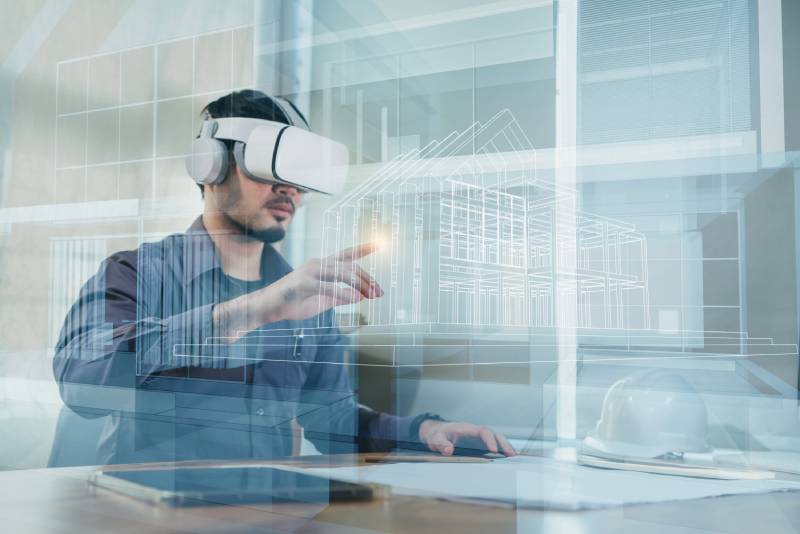Integrating technology in architectural design is transforming how architects plan, design, and execute projects. Technological advancements have revolutionized the field, making processes more efficient, designs more innovative, and buildings more sustainable. This blog explores how various technologies are reshaping architectural design and the many benefits they bring to the construction industry.
Building Information Modeling (BIM)
Building Information Modeling (BIM) is a digital representation of the physical and functional characteristics of a building. It serves as a shared knowledge resource for information about a facility, forming a reliable basis for decision-making throughout its lifecycle.
BIM software facilitates stakeholder collaboration, allowing architects, engineers, contractors, and clients to work together seamlessly. BIM’s improved accuracy and efficiency in design and construction lead to reduced errors, lower labor costs, and shorter project timelines. Its ability to simulate and analyze different design options ensures better outcomes during the design process, resulting in higher-quality buildings.
Virtual Reality (VR) and Augmented Reality (AR)
Virtual Reality (VR) and Augmented Reality (AR) are more than devices that can transport individuals into the world of their favorite video game. Virtual reality simulators immerse users in a wholly digital environment, while AR overlays digital information onto the real world. Both technologies have unique applications in architectural design.
VR and AR enable immersive design experiences for clients and designers. With VR, clients can virtually walk through a building before it is built, experiencing the space as if they were physically present. AR, on the other hand, allows designers to visualize changes in real time, overlaying design elements onto physical spaces to see how they will look and function.
These technologies are also valuable for training architects and general contractors. VR simulations provide a safe and controlled environment for practicing complex construction tasks, improving skills, and reducing on-site errors. AR can assist workers by providing real-time information and guidance, improving productivity and accuracy.
3D Printing
3D printing involves creating three-dimensional objects from digital models by adding material layer by layer. Architects use 3D printing to create detailed models and prototypes of commercial buildings and other structures to refine designs.
In construction, 3D printing can produce full-scale building components, such as walls and structural elements, with high precision and speed. This capability significantly reduces construction time and costs, allowing for greater customization and design complexity.
The advantages of 3D printing enable rapid prototyping so architects can test and iterate designs quickly. The reduction in material waste and the ability to use recycled materials contribute to more sustainable building practices.
Smart Building Systems
Smart building systems integrate advanced technologies to optimize building performance and maximize occupant comfort. These systems include a range of components such as sensors, automated controls, and data analytics platforms that work together to manage a building’s operations efficiently.
Energy efficiency is a major benefit of smart building systems. Smart buildings significantly reduce energy consumption by continuously monitoring and adjusting lighting, heating, cooling, and other systems based on real-time data. This not only lowers operational costs but also minimizes environmental impact.
For example, automated lighting and climate control improve occupant comfort by creating optimal indoor environments tailored to their preferences and needs. Smart technologies and other forms of artificial intelligence can also improve security, accessibility, and overall building management.
Drones in Architecture
Drones are particularly useful for site analysis and topographic surveys. They can quickly and accurately capture detailed aerial images and data, providing architects with valuable insights into the site conditions and helping to inform building design decisions. This capability reduces the time and cost associated with traditional surveying methods.
Drones play a crucial role in monitoring progress and ensuring quality control during construction. They can capture real-time images and videos of the construction site, allowing project managers to track the work more easily, identify potential issues, and make informed decisions promptly.
Parametric Design
Parametric design uses algorithms to define and manipulate design parameters, enabling architects to create complex and adaptable structures. This approach provides greater flexibility and innovation in architectural design.
The parametric design principles involve setting up rules and relationships between different design elements. By adjusting parameters, architects can explore a wide range of design possibilities and optimize forms and structures to meet specific requirements. This method is particularly useful for creating unique and non-standard architectural forms that would be difficult to achieve with traditional design techniques.
Sustainable Technologies
Sustainability is a key consideration in modern architectural design, and various technologies are being integrated to create greener and more sustainable buildings. Using sustainable and eco-friendly materials is a fundamental aspect of this approach.
Renewable Energy Integration
Renewable energy integration is another critical element of sustainable architectural design. Incorporating solar panels into buildings reduces their reliance on fossil fuels and lowers carbon emissions. These technologies make buildings more self-sufficient and environmentally friendly.
Water Conservation Systems
Water conservation systems are also essential for sustainable design. Technologies such as rainwater harvesting, greywater recycling, and low-flow fixtures help reduce water consumption and promote efficient use of water resources. Implementing these systems contributes to the overall sustainability of buildings and helps preserve natural resources.
Utilize Design Advancements with Fuse Architecture Studio in Austin, Texas
As technology continues to evolve, its impact on architecture will only grow, opening up new possibilities and opportunities for innovation. To leverage their full potential, architects and designers must stay abreast of these advancements. Fuse Architecture Studio is committed to utilizing technological integration with our projects to match the developments of human ingenuity and the highest sustainability standards. Contact us for expert guidance from our commercial architects in Austin, TX, to learn more about our work in Austin and beyond.

